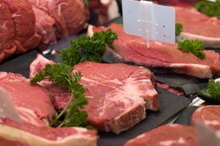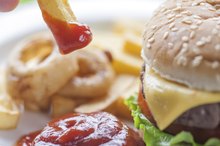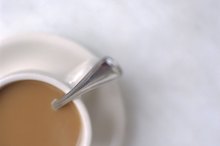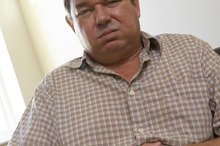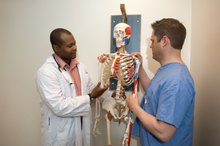What Are the Symptoms of a Gallbladder Problem?
The gallbladder is a small organ that is located near the upper right quadrant of the stomach under the ribcage. It stores bile that is produced by the liver and later secretes this bile into the intestines, where it assists in digesting fats. Many people with a bad gallbladder also develop gallstones, which can inhibit the natural functioning of the gallbladder. If you experience any of the common symptoms of a bad gallbladder, it is important to visit your physician for treatment 1. He will be able to determine if your condition can be managed with diet and medications, or if surgery is necessary to remove the diseased organ.
If you are experiencing serious medical symptoms, seek emergency treatment immediately.
Nausea and Vomiting
Nausea and vomiting is one of the most experienced symptoms of a bad gallbladder 12. When the gallbladder is not utilizing bile efficiently, the body becomes less able to digest fats that are ingested through dietary intake. This results in cases of nausea and sometimes vomiting. Some people may experience only mild nausea, while others may develop severe cases that often result in trips to the emergency room for medications and fluid replenishment.
- Nausea and vomiting is one of the most experienced symptoms of a bad gallbladder 1.
- When the gallbladder is not utilizing bile efficiently, the body becomes less able to digest fats that are ingested through dietary intake.
Diarrhea
Pain in the Upper Right Back After Eating
Learn More
When someone has a bad gallbladder, the body is less efficient or incapable of digesting fats. Fats are typically broken down in the intestines via bile. When the body is not able to break down these fats, they pass quickly through the intestinal tract. This will result in diarrhea. It is common for someone with a bad gallbladder to experience frequent and prolonged bouts of diarrhea. When not suffering from diarrhea, these people will experience soft stools that are not fully formed, yet not fully diarrhea.
- When someone has a bad gallbladder, the body is less efficient or incapable of digesting fats.
- When not suffering from diarrhea, these people will experience soft stools that are not fully formed, yet not fully diarrhea.
Stool Changes
Many people who suffer from a bad gallbladder will start noticing changes in their stool. As opposed to a solidly formed medium brown stool, their stool may appear yellow or light tan in color. Some may experience stool that is almost chalky in color. This is due to excess fats being present in the stool that are no longer being digested by the body. The stool may also develop a very strong and foul odor.
- Many people who suffer from a bad gallbladder will start noticing changes in their stool.
- Some may experience stool that is almost chalky in color.
Pain
Does Fasting Affect Your Gallbladder?
Learn More
A classic symptom of a bad gallbladder is pain 1. The gallbladder is located on the right side of the abdomen and under the ribcage. Pain will be located in this area and may radiate towards the center of the abdomen. The pain may also be present in the middle of the back directly underneath the ribcage and radiate towards the right side of the back. Pain is commonly stronger after a meal or snack that is high in grease or fat content.
- A classic symptom of a bad gallbladder is pain 1.
- The pain may also be present in the middle of the back directly underneath the ribcage and radiate towards the right side of the back.
Related Articles
References
- University of Maryland Medical Center: Gallstones and Gallbladder Disease-Symptoms
- National Institute of Diabetes and Digestive and Kidney Diseases. (n.d.). Gallstones. https://www.niddk.nih.gov/health-information/digestive-diseases/gallstones
- University of Maryland Medical Center. (2018). Gallstones and gallbladder disease. https://www.umms.org/ummc/patients-visitors/health-library/in-depth-patient-education-reports/articles/gallstones-and-gallbladder-disease
- Njeze GE. Gallstones. Niger J Surg. 2013;19(2):49-55. doi:10.4103/1117-6806.119236
- Maurer KJ, Carey MC, Fox JG. Roles of infection, inflammation, and the immune system in cholesterol gallstone formation. Gastroenterology. 2009;136(2):425-40. doi:10.1053/j.gastro.2008.12.031
- Halpin V. Acute cholecystitis. BMJ Clin Evid. 2014;2014:0411.
- Balmadrid B. Recent advances in management of acalculous cholecystitis. F1000Res. 2018;7: F1000 Faculty Rev-1660. doi:10.12688/f1000research.14886.1
- Ahmed M. Acute cholangitis - an update. World J Gastrointest Pathophysiol. 2018;9(1):1-7. doi:10.4291/wjgp.v9.i1.1
- Derici H, Kara C, Bozdag AD, Nazli O, Tansug T, Akca E. Diagnosis and treatment of gallbladder perforation. World J Gastroenterol. 2006;12(48):7832-6. doi:10.3748/wjg.v12.i48.7832
- Toouli J. Biliary Dyskinesia. Curr Treat Options Gastroenterol. 2002;5(4):285-291.
- Ahmed M, Diggory R. Acalculous gallbladder disease: the outcomes of treatment by laparoscopic cholecystectomy. Ann R Coll Surg Engl. 2011;93(3):209-12. doi:10.1308/003588411X563402
- Shaffer EA. Gallbladder cancer: the basics. Gastroenterol Hepatol (N Y). 2008;4(10):737-41.
- Wang JK, Foster SM, Wolff BG. Incidental gallstones. Perm J. 2009;13(2):50-4.
- Bree RL. Further observations on the usefulness of the sonographic Murphy sign in the evaluation of suspected acute cholecystitis. J Clin Ultrasound. 1995;23(3):169-72.
- Robinson P, Perkins JC. Approach to Patients with Epigastric Pain. Emerg Med Clin North Am. 2016;34(2):191-210. doi:10.1016/j.emc.2015.12.012
- Pejić MA, Milić DJ. [Surgical treatment of polypoid lesions of gallbladder]. Srp Arh Celok Lek. 2003;131(7-8):319-24.
- Genc V, Sulaimanov M, Cipe G, et al. What necessitates the conversion to open cholecystectomy? A retrospective analysis of 5164 consecutive laparoscopic operations. Clinics (Sao Paulo). 2011;66(3):417-20. doi:10.1590/S1807-59322011000300009
- Katzarov AK, Dunkov ZI, Popadiin I, Katzarov KS. How to measure quality in endoscopic retrograde cholangiopancreatography (ERCP). Ann Transl Med. 2018;6(13):265. doi:10.21037/atm.2018.05.01
- Catalano MF, Thosani NC. (2016). Clinical manifestations and diagnosis of sphincter of Oddi dysfunction. Howell DA (ed). UpToDate, Waltham, MA: UpToDate Inc.
- Lee JY, Keane MG, Pereira S. Diagnosis and treatment of gallstone disease. Practitioner. 2015 Jun;259(1783):15-9,2.
- National Institute of Diabetes and Digestive and Kidney Diseases. (n.d.). Gallstones.
- University of Maryland Medical Center. (2018). Gallstones and gallbladder disease.
Writer Bio
Iva Gutowski is a practicing nurse with health care experience since 2001. She has worked in the hospital setting on medical/surgical floors and critical care units. She has been a writer since 1999. Her experience includes articles for "The Asheville Citizen-Times," "The McDowell News," and "The Old Fort News." Gutowski holds a License Practical Nursing degree from McDowell Technical Community College


